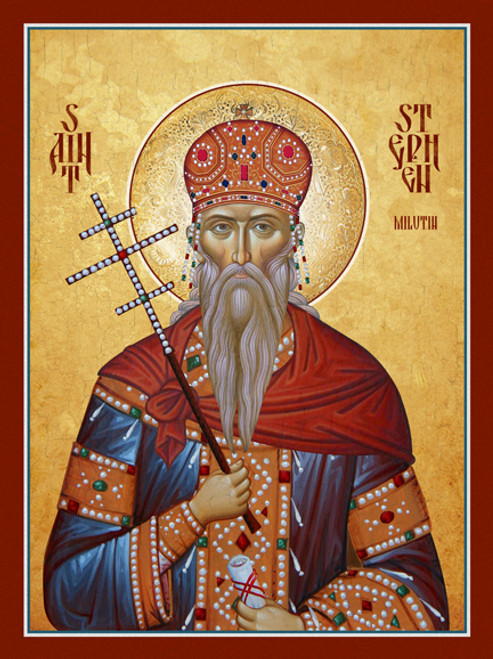ST KENNETH, ABBOT OF AGHABOE IN IRELAND (+600)
Commemorated October 11 and August 1
St. Kenneth's life and miracles are documented by Saint Adomnán, the ninth abbot of Iona who died in 704. Adomnán was a hagiographer and his greatest work Vita Columbae or Life of St. Columba contains references to St. Kenneth.
His father Lughadh Leithdhearg was descended from the CorcoDalann or Ui Dalainn, a tribe whose ancestor, Dalann, is traced back to Fergus (King of Ulster), son of Ross, son of Rudhraighe. The Corco-Dalann were from an island referred to as "Insula Nuligi", and is usually identified with Inis-Doimhle or Inis-Uladh, which is now the Little Island, in the River Suir, south-east of Waterford.
Lughadh was a distinguished bard, a highly trained, professional itinerant poet. Lughadh settled at Glengiven, in what is now County Londonderry. Lughadh ended up under the favour and protection of the chief of Cianachta, and became the tutor of the chieftain's son, Geal Breagach.
St. Kenneth's mother was called Maul or Mella. She attained an eminent degree of sanctity. The church of Thompleamoul or Capella Sanctae Maulae seu Mellae, beside Kilkenny city, was dedicated to God under her invocation.
In early Christian Ireland the druid tradition collapsed, with the spread of the new faith. The study of Latin and Christian theology flourished in monasteries.
Young Kenneth spent his early years watching his chieftain's flocks. In 543 Kenneth became a pupil at Finnian's monastic school at Clonard. During the sixth century, some of the most significant names in the history of Irish Christianity studied at the Clonard monastery. Twelve students who studied under St. Finian became known as the Twelve Apostles of Ireland and Kenneth was one of these. It was at Clonard that Kenneth became a friend and companion of St Colmcille (Columba).
In 544 he studied under St. Mobhi at the school of Glasnevin, with Kieran of Clonmacnoise and St. Comgall of Bangor. When plague scattered that community, he went to Saint Cadoc's monastery of Llancarfan in Glamorganshire in Wales, where he was ordained a priest in 545.
He left for Rome to obtain the blessing of the reigning pontiff. In 550 he had returned to Glengiven, where he converted his foster-brother, Geal-Breagach, who afterwards assisted him in founding Drumachose, in nearby Limavady.
In 565 Keneth joined Columba in Scotland. Adamnan tells of the arrival of Kenneth, on Iona. St. Columba had a prophecy of a "certain holy and excellent man, who will arrive here among us before evening." According to Adamnan, God provided Kenneth with a safe and calm crossing, even though the sea was perilous and stormy that day. St. Columba received him that evening with all honour and hospitality.
Kenneth built a church in the place now known as Saint Andrews. He built monastic cells on the island of Ibdon and Eninis, an oratory called Lagan-Kenny on the shores of Loch Laggan (the remains of which are marked on the OS map), and a monastery in Fife on the banks of the Eden. Kenneth's name is still recalled in the ruins of an ancient church, Kil-Chainnech on Tiree Island, in a burial ground, Kil-Chainnech, in Iona and Inch Kenneth off Mull.
Kenneth spent a good deal of his time in County Meath and Ossory in what is now County Laois. In Ossory he had a good repute with the king, Colmann son of Feradach. Colman gave him grants of land including Aghaboe ("the field of the Ox") which became his principal monastery. Aghaboe grew in importance, and in the 7th century sent St. Feargal as a missionary to the church of Salzburg, Austria. Aghaboe was for a time the site of the bishop's see until under Norman influence in the twelfth century the see transferred from Aghaboe to Kilkenny. In 1346 Diarmaid Mac Giollaphádraig burned the town of Aghaboe, and completely destroyed Kenneth's shrine along with his relics.
Kilkenny (Irish: Cill Chainnigh "The Church of Keneth") was originally the name of a church erected by or dedicated to Kenneth, but was afterwards extended to the townland and parish. Kilkenny was one of the last parts of Ireland to be converted to Christianity. Tradition asserts that in 597, Kenneth led a Christian force to Kilkenny to eliminate the last bastion of Druidic rule in Ireland. The last Archdruid of Ireland had retired with his Council to a mound in Kilkenny for safety. Kennth led an army there and overcame them. He founded a monastery near what is now the Church of Ireland's St. Canice's Cathedral. He died and was interred at Abbey of Aghaboe in 599/600.
In his old age St. Kenneth retired to an island in what was once Loch Cree, and wrote a commentary on all four Gospels. This became known as Glass Kinnich (Glas-Chainnigh) or Chain of Kenneth. This was long preserved in his church and became a continuous commentary in the Middle Ages.
St. Kenneth is the patron of Aghaboe and together with St. Ciarán of Saigir, is one of the patrons of Kilkenny and the historic kingdom of Osraige. St. Kenneth is also the patron saint of the shipwrecked.
More can be found about St. Kenneth here.
Alternate spellings: Cainnech, Canice, Canicus, Kenny.







